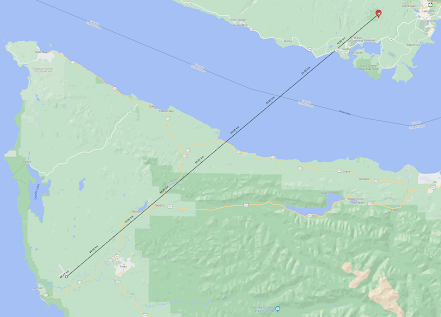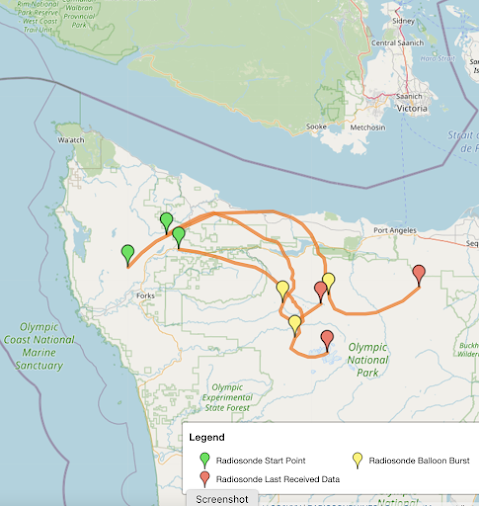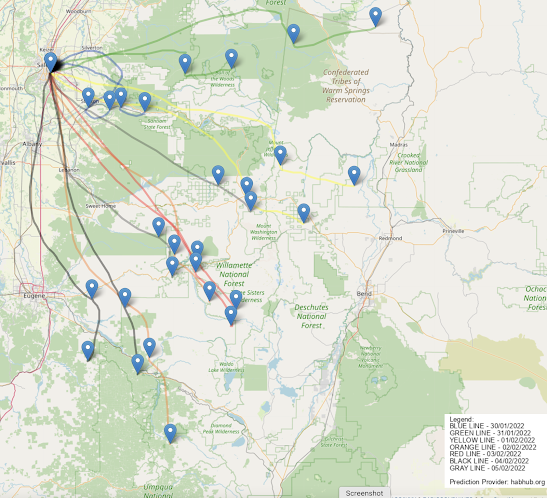One of the backbones of the meteorological observing network is the radiosonde, a balloon-launched weather station that rises to around 110,000 feet before the balloon bursts and the instrument package plummets back to Earth, slowed by a small parachute.
Such radiosondes are launched twice a day at approximately 1000 locations around the world.
Most U.S. National Weather Service sites use a radiosonde made by the Finnish company Vaisalla, and specifically, the RS 41 unit shown below. The projection at the top has the temperature and humidity sensors, a digital barometer is inside, and winds are derived by tracking the movement of the unit.
One of the great pleasures of doing this blog is the emails I receive from many of you, with all kinds of observations and questions.
Well, today I got an email from Ian Cruickshank; while he was hiking in the forest in the Sooke Hills near Victoria, BC, guess what he found? An American radiosonde unit (see the proof below).
He asked me where it was launched and I knew there was really only one possibility: the National Weather Service launch site at the Quillayute Airport on the Olympic Peninsula. Here is a map showing the radiosonde launch location and where the unit ended up. About 55 miles away.
I am often asked what one should do with one of these units if you find one. In the old days, the NWS wanted you to return them....no longer. Just trash it...or better yet, keep it as a rare souvenir.
There are hobbyists that maintain websites that track radiosondes, acquire their weather data, and attempt to find them after landing. One such site showed the recent landing locations of the radiosondes launched from Quillayute the past few days (below). Most of them landed in Olympic National Park.
And consider the routes taken by the Salem, Oregon radiosonde (see below)--mainly landing in the central Oregon Cascades. That looks like a good place to go radiosonde searching.
If there is a really strong jet stream, radiosondes can travel up to two hundred miles downwind during their typical two-hour flight.
Perhaps the most amusing radiosonde recovery story occurred a few years ago in my Atmospheric Sciences 101 class. I had just given a lecture about radiosondes and the next day a student walked in with one. Smiling. I was dumbfounded. While he was playing basketball at a frat house in the University District, a radiosonde had floated in.
I gave him extra credit, of course.









IN the 1990s I worked on the Chemult Ranger District of the Winema National Forest in South Central Oregon. Each year one or two radiosondes would be found by Forest service employees working in the woods. There was a packet attached to each one with a mailing envelope and instructions to mail it back to the National Weather Service. I think they were all launched from Medford, 80 miles southwest of Chemult.
ReplyDeleteCliff,
ReplyDeleteI'm one of several here in Oregon who track the balloons. We receive the transmitter in the Radiosonde and decode the transmissions so we can see where they land. Here's a link to a posting where the Ham picked up the Radiosonde yesterday.
https://groups.io/g/Balloons/topic/jan_29_morning_balloon/88767816
We also report our tracking info to aprs.fi. here's the last 12 hours showing the track of this morning's balloon from Salem, OR
https://aprs.fi/#!mt=roadmap&z=10&call=&others=1&timerange=43200&tail=43200
August Johnson KG7BZ
Oops, posted the wrong aprs.fi link. Just zoom back and pan to oregon and zoom in. Set the track length to 12 or 24 hours.
DeleteAugust KG7BZ
If you click on the little red dots on the balloon track, you will see the data from the sonde at that point. Pressure, temp, %RH, altitude, Climb or fall, battery voltage, radio frequency of sonde, ground speed and heading. The ones I track usually burst around 100,000 feet. There are quite a few hobbyists tracking these balloons, for fun and hoping to be able to retrieve one or more.
DeleteCliff, Is there controversy over the possible hazard if a radiosonde floats down over the freeway or an airport? And although I have never found one, what about not littering up the wilderness? Although, in years of hiking I have never found one, and of course I would remove one if I found it. But two thousand a day? That is very roughly one per square mile every 4.3 years, if they were evenly distributed across the conterminous USA...
ReplyDeleteThat's not the USA only, that's the whole world. The ones these days only weigh a few ounces.
DeleteMy question is what sort of batteries they have since they are littering all over our wild lands? The plastic is bad enough, but if over time the case degrades and leaks battery chemicals of a particularly toxic nature then the weather enthusiast in me takes back seat to the wilderness enthusiast who wants some damn place to go without human trash in it, and where the wildlife and plants have a reasonable chance to live a healthy life.
ReplyDeleteTwo thumbs up! Cliff- comments?
DeleteAll the RS41's I've seen have 2 AA Alkaline batteries in them.
DeleteI understand your sentiment Brian W but the engineering to get a device up to 100000 feet and operate in a -50 degree or colder environment while being able to handle 150+ mph winds is not insignificant. If you could come up with a solution with a smaller footprint I'm sure there is money to be made.
DeleteThe ability to input the data of the atmospheric state into weather computers from every place on the globe, at the same time, every twelve hours, is the cornerstone of weather observation. The benefit to weather observation and prediction far outweighs the negative impacts. Every country on earth, save North Korea, sends up balloons, simultaneously, every 12 hours and shares this information
DeleteI found one around 11000' deep in the Sierra Nevada in 2001, probably from NWS Hanford. It was packed in a large styrofoam cube, fitting it into my pack wasn't possible. I later redeemed myself a pinch by packing out a mylar Tigger balloon from someone's birthday party far far away.
ReplyDeleteIt seems a waste not to try and return radiosondes. Don't those radiosondes have some fancy electronics. If I bought a new thermometer every day wouldn't you consider that wasteful.
ReplyDeleteI use software from this site (Where Cliff got his tracks, BTW) running on a Raspberry Pi computer and a $35 RTL-SDR receiver to receive and track the balloons. I can receive them over 100 miles away from my house. The Program reports the data to that web site which gathers data from trackers all over the world.
ReplyDeletehttps://radiosondy.info/
I recovered a sonde when it landed on the roof of a house only a couple miles away from my house. I was receiving it all the time and the GPS coordinates it was broadcasting told me exactly where it was!
The labeling on radiosondes is more than a little troubling to me. If I were attempting to do something devious, I would probably label them "Harmless Weather Instrument" and "This is not dangerous"
ReplyDeleteOnce while hiking in the mountains east of Anchorage I saw one coming down!
ReplyDeleteYears earlier when I was interning at the weather office in Nome and was in the midst of analyzing the sounding (this was many years ago when the data was inked on moving paper as it came in and had to be hand analyzed) someone brought in a radiosonde, battery still warm. It freaked me out since I was still receiving data, but it must have been from the previous launch.
For those concerned about littering up the countryside, think of the tremendous benefit derived from the upper air program. Does it not dwarf the small chance that you will see a small weather instrument out in the wilderness? Pack it out and most people will never see one. The balloons, string, paper parachute are all biodegradable I believe. Maybe the body of the instrument is now or will be some day?
I've never found a sonde, but in 1962 I found a message in a bottle on the beach at Crescent City CA. It was from whatever agency passed for NOAA at the time. There was an oceanic current survey form inside asking when and where it was found. Got a $1 reward for sending it in and I still have the bottle :-)
ReplyDeleteI guess nowadays they use radiosonde buoys or spilled rubber duckies and sneakers
It would be cool if they used drones to glide them back to the airport. Having them fall to the ground seems like a waste and a littering problem.
ReplyDelete